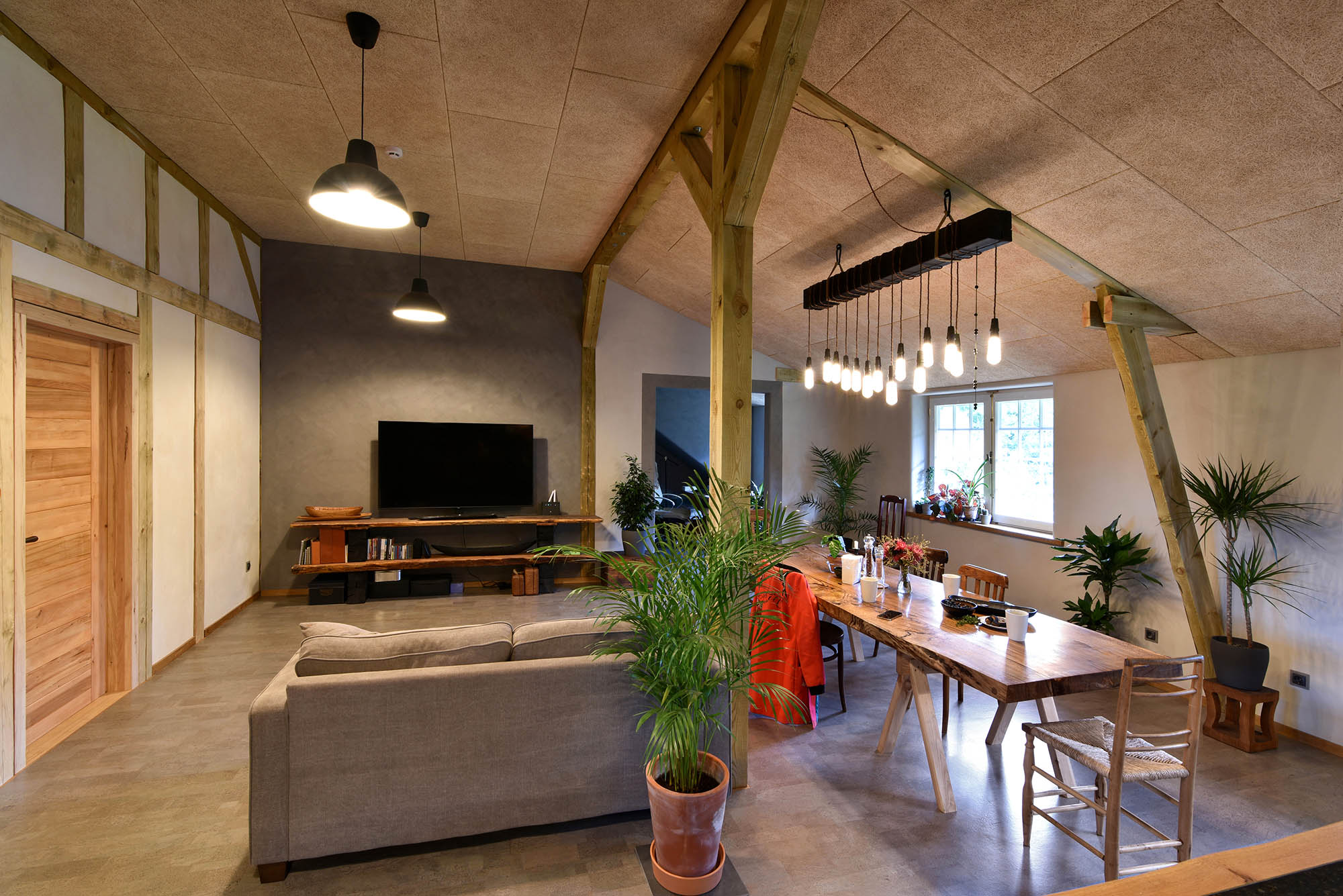Solving Echo in Living Rooms: Easy Fixes for Better Sound and Comfort
Modern architecture is all about clean lines, open-concept layouts, and expansive hard and reflective surfaces like wood, concrete, metal, stone, drywall and glass. These design choices look stunning but often come with an unwelcome side effect: echo in your living room. You’ve likely noticed it when watching a movie, hosting friends, or simply chatting with family. The room just feels “off,” bouncing around and making conversations harder to follow. Luckily, fixing this issue doesn’t mean sacrificing your aesthetic.
In this article, we’ll explain how with the right mix of soft furnishings and stylish acoustic surfaces, you can enjoy a quieter, more comfortable living space.
Why Does Echo Happen in Living Rooms?
At its core, echo is the result of sound reflecting off hard, flat surfaces instead of being absorbed. In technical terms, this is known as reverberation. It’s different from an echo in the mountains or a canyon, because what you hear in your living room is more of a lingering or muddled repetition that reduces sound clarity.
Have you ever wondered why, especially in modern homes or an open concept home, are highly susceptible to these acoustic issues? These types of rooms typically feature hardwood floors, high ceilings, beautiful wood accents, bare walls, and large glass windows – all materials that reflect sound instead of dampening it. Add to that a minimalist design trend with fewer rugs or curtains, and you’ve created the perfect environment for echo.
But first, it’s important to understand the difference between soundproofing vs sound absorption. While soundproofing blocks or reduces sound from entering or exiting a space, sound absorption controls sound within the room to minimize echo and improve the sound quality within the space. Understanding the difference between reverb and true echo can help:
- Echo is a distinct repetition of sound and is generally associated with massive amounts of air–like stadiums, gyms, or outdoor environments with reflective surfaces off in the distance.
- Reverberation is a prolonged, blurry tail of sound that overlaps the original signal. Reverberation is more applicable to smaller spaces than those noted above. Lunchrooms, conference rooms, classrooms, and residential rooms like living rooms.
In many cases, you’re dealing with both, but to varying degrees, and this is especially true in open-concept homes with minimal furnishings and large shared spaces. Picture yourself standing in a newly built living room overlooking the ocean, through a wall primarily constructed of windows. You can feel the texture of the hardwood below your feet, and as you look up to a lofted ceiling and second floor catwalk on the side of the room opposite the windows, you wonder when someone is going to put some furniture or pictures on the wall.
Imagine you are somehow able to hold a hundred super balls and throw them as hard as you can toward the windows and realize that, magically, gravity has nearly no effect on the superballs in this space. They are bouncing at 761.2 miles per hour–which is the speed of sound at sea level (also known as Mach 1). In no time at all, the balls are simultaneously reflecting off of the walls, ceiling, floor, and each other, and traveling in all directions at once. This is exactly how reverberation works in a room.
Simple Ways to Reduce Echo in a Living Room
If you’re wondering how to make a room quieter without calling in a pro, the good news is that there are several easy, design-friendly fixes that can improve living room acoustics without remodeling.
From plush rugs to stylish acoustic panels, there’s no shortage of acoustic decor ideas to help turn your echo-prone living room into a serene soundscape. Here are some ideas:
Add Soft Furnishings and Decor
The quickest way to begin reducing echo is by softening your surfaces.
- Area rugs or carpet runners absorb footfalls and break up sound pathways.
- Plush sofas and chairs, especially those with fabric upholstery, help absorb sound.
- Add throw pillows, blankets, and fabric wall hangings for both comfort and sound reduction.
- Window treatments like thick, full fabrics and honeycomb mini blinds can reduce a significant amount of reflection off of windows when they are deployed.
- Bookshelves, especially when full, act as partial sound diffusers, breaking hard, flat surfaces, making perimeter walls less reflective than drywall.
As you can see, simple additions like rugs, curtains, and upholstered furniture can dramatically reduce echo in home environments, especially in acoustically reflective spaces like the living room.
Use Curtains and Window Treatments
Large glass windows are notorious echo producers. Installing heavy drapes, Roman shades, or honeycomb blinds over windows not only helps control light but also softens reflected sound.\
Even better, they offer a decorative opportunity to bring color and texture into your living space, without relying on “acoustic curtains,” which tend to conjure up industrial imagery.
Incorporate Plants and Decor with Texture
Large leafy plants are trendy and can function as minimalist, natural sound diffusers. Strategically placing a few in corners or near windows can help break up sound waves. Additionally, textured furniture, woven baskets, or macrame wall decor can all contribute to creating a space that’s visually warm and acoustically balanced.
Plants aren’t going to do nearly as much as an acoustical panel or a soft plush couch, but if it works in the space visually and provides some free acoustical performance, why not?
Acoustic Products That Quiet a Living Room Without Compromising Style
For a more advanced, design-conscious approach to echo control, we offer a range of acoustical materials and surfaces that blend beautifully into residential environments. These options go beyond the basics, providing sound absorption where soft furnishings can’t reach.
Fabric-Wrapped Acoustic Panels
Fabric-wrapped acoustic panels are a go-to solution for those who want to reduce echo without disrupting their home’s aesthetic. These panels come in a variety of designer fabrics, sizes, and finishes, allowing them to blend into existing decor or stand out as statement pieces.
Looking for something more artistic? Check out acoustic wall art that doubles as décor and echo control.
For larger or more acoustically challenging rooms, installing echo reduction panels can make a real difference in improving overall sound clarity. Installing sound absorbing wall panels helps break up sound waves and reduces echo on large, flat surfaces. Our customizable fabric panels for echo control are designed to blend into your space while significantly improving acoustics.
Decorative PET Felt Panels
Modern and sustainable, decorative PET felt panels or our new Poly Max Designs are amazingly versatile options. Available in geometric patterns or printed with logos or images, these panels not only absorb sound but also beautify your design scheme. Lightweight and easy to install, they’re ideal for renters or those hesitant to make permanent changes.
Our line of decorative sound panels offers the perfect marriage of acoustic function and visual appeal, giving homeowners an attractive way to manage echo.
Ceiling Acoustic Clouds or Baffles
Wondering how to fix echo in high ceilings? That sound bouncing above your head is a common issue in homes with vaulted or double-height ceilings. Installing ceiling clouds or baffles addresses this problem head-on. These hanging acoustic panels reduce reverberation from above without altering wall decor, making them perfect for tall, echo-prone spaces.
If your living room features high or vaulted ceilings, an acoustic ceiling treatment like this can help reduce unwanted reverberation from above.
How to Know if You Need Professional Help
While DIY decor changes and acoustic panels can go a long way, there are cases where expert guidance is necessary. Consider professional help if:
- You live in an open floor plan where sound travels between rooms.
- You’ve added furnishings and decor but still experience reverb.
- You have a home theater, music studio, or sound-sensitive space where clarity is essential.
- Work-from-home calls or family movie nights are impacted by poor sound quality.
One of our acoustic experts would be happy to help you evaluate the specific needs of your room and recommend a custom mix of acoustic treatment for homes that fits both your functional and design goals.
Fix Echo in Living Rooms with Acoustic Geometry
At Acoustic Geometry, we specialize in tailored acoustic solutions for living rooms that enhance comfort without compromising your design aesthetic. Whether you’re dealing with reverb from hardwood floors, struggling with echo problems in modern homes, or simply want to improve your living room acoustics, we are here to help. Our range of acoustical options combine performance with design, offering something for every style and space, that will fix echo in your living room.
We offer:
- Free consultations to assess your echo issues and offer tailored solutions
- Full room acoustic treatment kits for complete echo control
- Noise reduction panels designed for home use
- A wide selection of acoustic fabrics to match any décor
- Custom sizes and finishes to suit every room
Trusted by homeowners, interior designers, and AV professionals, our products are built to enhance both your space and your sound.
Don’t let echo ruin the comfort of your favorite room. From adding soft furnishings and window treatments to installing stylish, high-performance acoustic panels, there are plenty of ways to reduce reverberation while keeping your design intact. With our expert products and guidance, your living room can sound as good as it looks.





















Add comment
You must be logged in to post a comment.